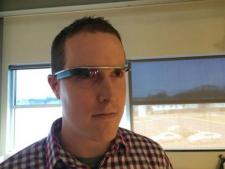
Google is expanding it's outreach for their Glass platform to the community by providing more and more accessibility through their explorer program. Google now offers access to the Glass Explorer Program without having to go to Google and pick up the glasses personally. Trekk, my employer, saw this as an opportunity to get involved in shaping the way augmented reality is experienced on Glassware by ordering a pair and getting our technical department involved right away.
The Google Glass Experience
Experiencing Google Glass for the first time was extremely interesting and very odd all at the same time. When I first put a pair on I was very disorientated until I learned how to interact with Glass on. Most of my attention was directed to Glass and I would just stand there looking and speaking to Glass like I was Morpheus telling Tank to load the jump program. I also had a lot of issues with both of my eyes always wanting to focus in on Glass and could not wear them for very long until I got used to it.
One of the many things I really did like about Glass is that you can speak to it to run commands. Tapping on the touch pad and saying, "OK Glass," will bring up a prompt menu that you can choose from many different options to tell Glass to perform activities. This is almost like touching the home screen button on a mobile device as it gives the user many options for interaction. Another thing I really liked about Glass was the camera. Being able to command Glass to take a picture or record video was really great. Along with commanding Glass to take a picture you were also able to get directions to places based upon your current location, which I could see as a major use for Glass.
Developing on Glass
Developing for Glass comes with many options. It really all depends what you are looking to do with Glass as a developer. The first approach would be through their native GDK using Java. The native approach will give you access to hardware and real-time interaction, but it will also let your Glassware run without a network connection. The native approach is good news for Android developers as the GDK is an extension of the Android Development Kit and requires familiarity with the Android platform to get off the ground.
The second approach to development would be using the Mirror API which gives the developer the freedom to develop their software agnostically on any type of server. The Mirror API will give you access to already built in features of Glassware. Basically, Glass can interact with your server application, sending and receiving data to enrich the Glass experience.
The last approach to development would be using a hybrid model of the first two approaches. This approach would mean developing Glassware with the GDK and then having the Mirror API send and receive data to your service. This approach seems like it would be the most applicable as most applications on any platform these days have a network connection of some sort.
Hopefully I will get a chance to get a tutorial on Glass up soon!



